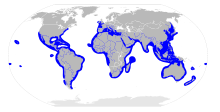Hammerhead shark
The Hammerhead sharks are a group of sharks which make up the family Sphyrnidae. Their unusual head looks like a hammer. This "hammer" on its head is also known as the "cephalofoil". Of the nine species of the Hammerhead sharks, the Winghead shark is in the genus Eusphyra, and the other eight are in the genus Sphyrna.
| Hammerhead shark Temporal range: Middle Miocene to Present
| |
|---|---|

| |
| A Hammerhead shark, Sphyrna lewini | |
| Scientific classification | |
| Kingdom: | |
| Phylum: | |
| Class: | |
| Subclass: | |
| Order: | |
| Family: | Sphyrnidae
|
| Genera | |

| |
| Map of Hammerhead Sharks (In blue) | |
Description change
There are nine known species of Hammerhead sharks. They range from the length of 1.00 meters to the length of 6 meters, and weigh from 500 pounds (225 kg) to 1000 pounds (450 kg). They are usually light grey with a tint of green, but some are more greener in colour then others, and the belly in white.
The unusual structure of the head makes the head look like a hammer, this is why they are known as "Hammerhead sharks". Since the eyes are positioned on the ends of the cephalofoil, Hammerheads are able to see everything around them, including what is under them, and what is above them.[1] This head helps hammerhead sharks make very tight turns in the water, and it also helps them sense prey.
Feeding change
Hammerhead sharks are aggressive hunters and feed on crustaceans, molluscs like octopuses and squids, and many types of fish. They also eat other types of sharks. Hammerhead Sharks favourite type of food is stingrays. They are known to swim along the bottom of the ocean, following their prey. Hammerhead sharks use their cephalofoil as a weapon to hunt for stingrays; they hit stingrays with their cephalofoil to weaken the stingray, and then eat the stingray. When Hammerhead Sharks can not find food, they have been known to eat each other, but Great hammerhead sharks have been known to eat their own young.
Reproduction change
Hammerhead Sharks are viviparous, meaning they give live birth. Females usually give birth to 12 to 15 pups at a time, but the Great hammerhead shark gives birth to around 20 to 40 pups at a time. Once they are born, baby Hammerhead sharks come together in groups and swim towards warmer waters. They stay together in groups until they are older and big enough to live on their own. Hammerhead shark live for around 20 to 30 years. In 2007, the bonnethead was found to be capable of asexual reproduction, making it the first shark to be able to do this.
Evolution change
The hammerhead sharks are a monophyletic group. sequence analysis shows they evolved from the Winghead shark.[2]
Species change
- Genus Eusphyra:
- Winghead Shark, Eusphyra blochii
- Genus Sphyrna:
- Scalloped Bonnethead, Sphyrna corona
- Scalloped Hammerhead Shark, Sphyrna lewini
- Scoophead, Sphyrna media
- Great hammerhead shark, Sphyrna mokarran
- Bonnethead, Sphyrna tiburo
- Smalleye Hammerhead Shark, Sphyrna tudes
- Smooth Hammerhead Shark, Sphyrna zygaena
- Whitefin Hammerhead Shark, Sphyrna couardi
Relationship with humans change
Out of the nine species of Hammerhead sharks three are dangerous to humans: the Scalloped Hammerhead shark, the Great hammerhead shark, and the Smooth Hammerhead shark. The Great and Scalloped are listed as endangered by the International Union for the Conservation of Nature, while the Smalleye Hammerhead shark is listed as vulnerable. This is because of over-fishing for the fins of Hammerhead sharks, which are used in sharkfin soup. In 2010, 33 attacks were reported, but none of these attacks were fatal.
Hawaiian culture change
In Hawaiian culture, sharks are considered to be gods of the seas, they are also known as aumakua, protectors of humans, and cleaners of ocean life. Some of these sharks are believed to be family members who have died and have turned into sharks. But there are some sharks which are known as niuhi, or man-eaters. These sharks include Great White Sharks, Tiger sharks, and Bull sharks. The Hammerhead sharks are known as mano kihikihi, they are not considered as man-eaters or niuhi, but are considered one of the most respected sharks in the oceans, an aumakua. Many Hawaiians believe that they have an aumakua which watches over them and protects them from the niuhi.
References change
- ↑ Enhanced visual fields in hammerhead sharks. [1]
- ↑ Martin, R.A. 2005. Origin and evolution of the hammer.[2]
- Hammerhead Sharks Archived 2011-07-07 at the Wayback Machine
- National Geographic-Hammerhead Sharks
- Marine Parks-Hammerhead Sharks Archived 2012-08-25 at the Wayback Machine